Microeconomics Assignment: Export Subsidies, Import Quotas and Trade
VerifiedAdded on 2020/05/28
|6
|915
|69
Homework Assignment
AI Summary
This microeconomics assignment analyzes the effects of export subsidies and import quotas on market equilibrium and welfare. The assignment begins by examining the impact of an export subsidy on the beef market in Australia, illustrating how it affects domestic prices, supply, demand, and the volume of exports. It then assesses the welfare implications of the subsidy for consumers, producers, and the government, highlighting the overall negative impact on national welfare. The assignment further explores the effects of an import quota on the beef market in Canada, detailing how it influences prices, consumer surplus, producer surplus, and quota rents, ultimately leading to a welfare loss. Finally, the assignment discusses two arguments in favor of trade protection: the infant industry argument, which supports protection for developing industries, and the diversification of industry argument, which advocates for trade restrictions to promote a more balanced economy.
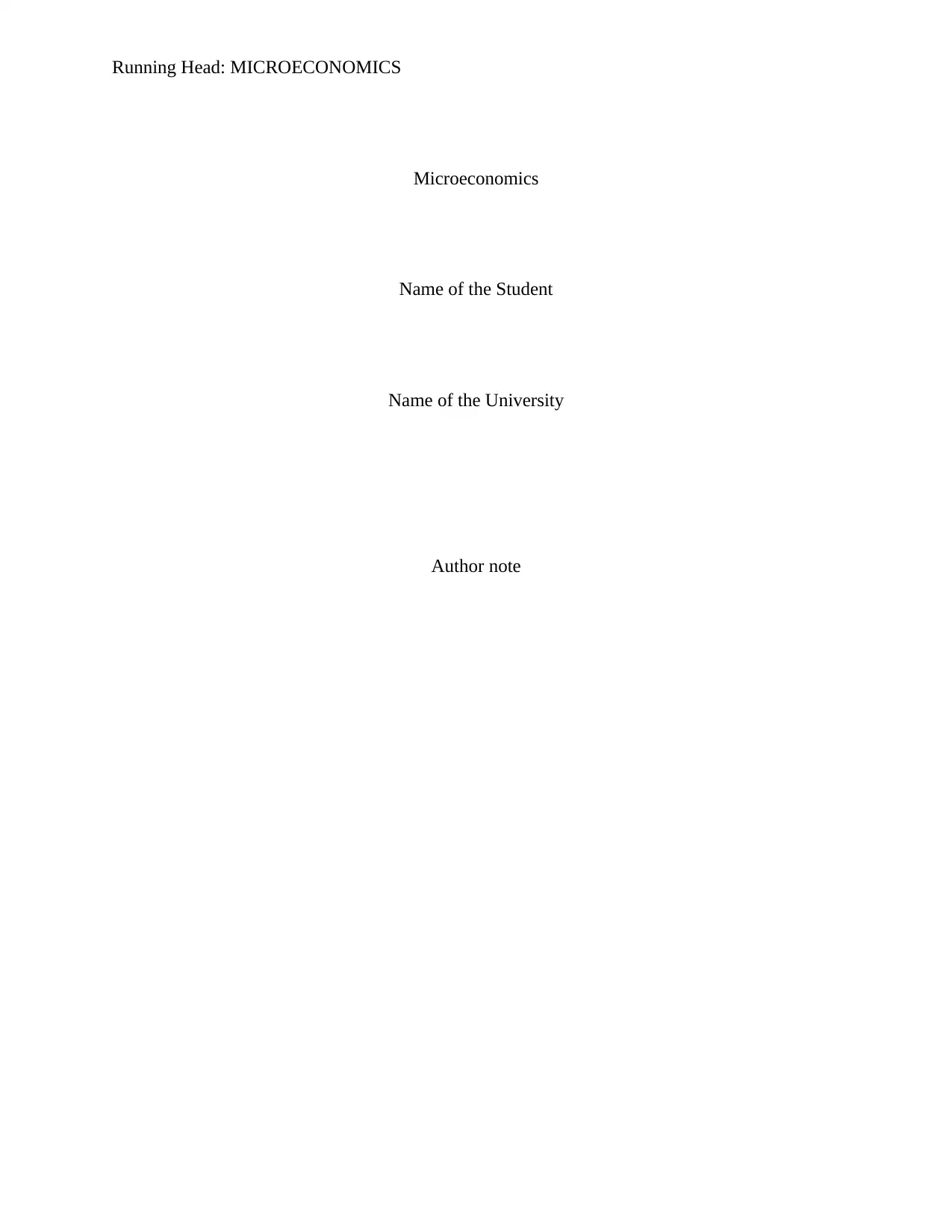
Running Head: MICROECONOMICS
Microeconomics
Name of the Student
Name of the University
Author note
Microeconomics
Name of the Student
Name of the University
Author note
Paraphrase This Document
Need a fresh take? Get an instant paraphrase of this document with our AI Paraphraser
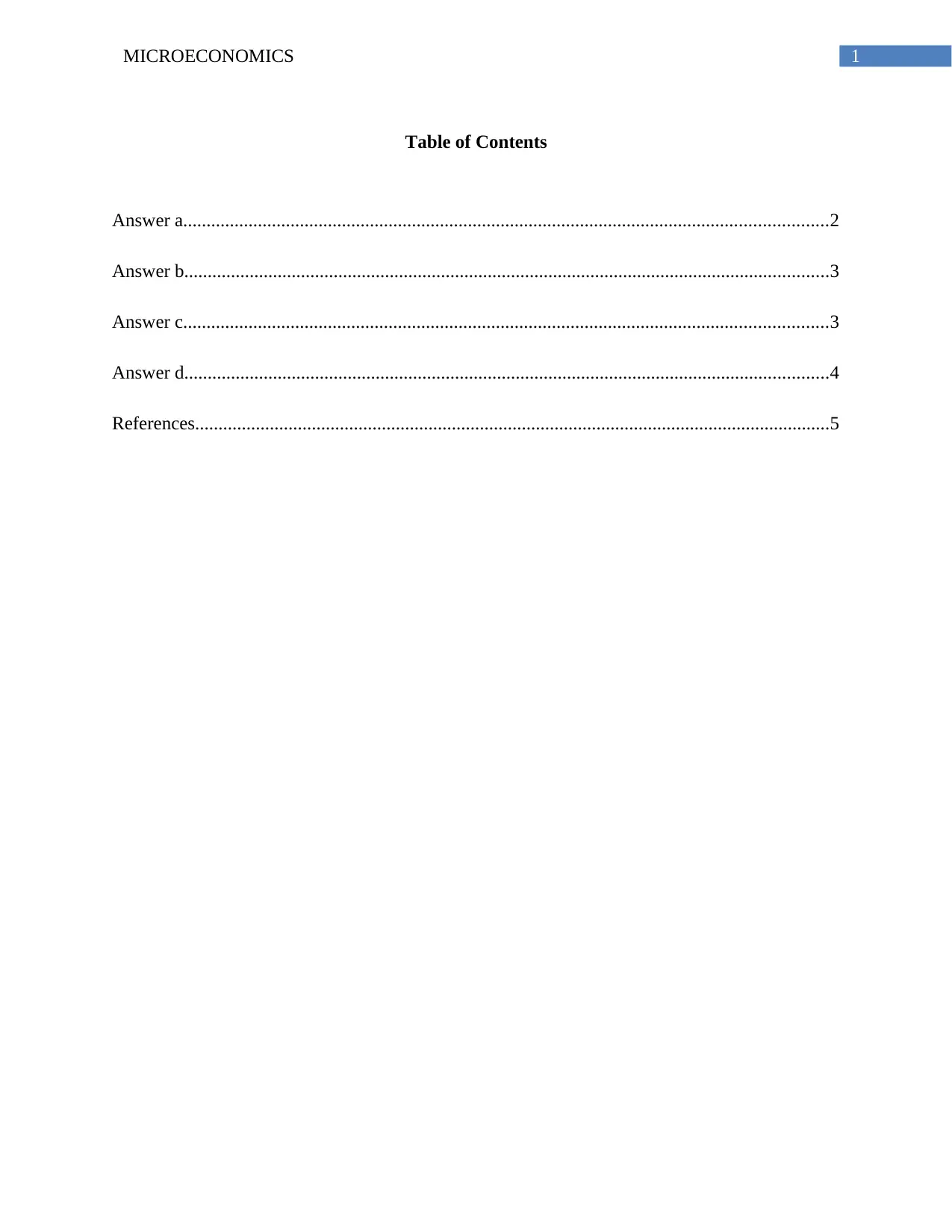
1MICROECONOMICS
Table of Contents
Answer a..........................................................................................................................................2
Answer b..........................................................................................................................................3
Answer c..........................................................................................................................................3
Answer d..........................................................................................................................................4
References........................................................................................................................................5
Table of Contents
Answer a..........................................................................................................................................2
Answer b..........................................................................................................................................3
Answer c..........................................................................................................................................3
Answer d..........................................................................................................................................4
References........................................................................................................................................5

2MICROECONOMICS
Answer a
Government provides export subsidy to promote export in the country. The following
figure explain the effect of a subsidy on beef exported from Australia to Canada.
Figure 1: Effect of export subsidy in Australia
(Source: as created by Author)
In the above DD and SS are the domestic demand and domestic supply curve of beef. The
world price is set at PW. At this price, domestic demand of beef equals D0 and domestic supply is
S0. At the world price the Australia exported (D0 – S0) amount of beef. Suppose that, government
provides a subsidy of s. The subsidy raises price received by the domestic exporter to PWS. The
domestic consumers now faced a high price. The high price received by the domestic beef
producers now encourage them to produce more (Gopinath, G., Helpman, E. and Rogoff, K. eds.,
2014). At the price PWS, the domestic supply now increases to S1 while domestic demand reduces
to D1. The increased supply and reduced demand in the domestic market increase the volume of
export. The quantity of beef exported now become (S1 – D1)
Answer a
Government provides export subsidy to promote export in the country. The following
figure explain the effect of a subsidy on beef exported from Australia to Canada.
Figure 1: Effect of export subsidy in Australia
(Source: as created by Author)
In the above DD and SS are the domestic demand and domestic supply curve of beef. The
world price is set at PW. At this price, domestic demand of beef equals D0 and domestic supply is
S0. At the world price the Australia exported (D0 – S0) amount of beef. Suppose that, government
provides a subsidy of s. The subsidy raises price received by the domestic exporter to PWS. The
domestic consumers now faced a high price. The high price received by the domestic beef
producers now encourage them to produce more (Gopinath, G., Helpman, E. and Rogoff, K. eds.,
2014). At the price PWS, the domestic supply now increases to S1 while domestic demand reduces
to D1. The increased supply and reduced demand in the domestic market increase the volume of
export. The quantity of beef exported now become (S1 – D1)
⊘ This is a preview!⊘
Do you want full access?
Subscribe today to unlock all pages.

Trusted by 1+ million students worldwide
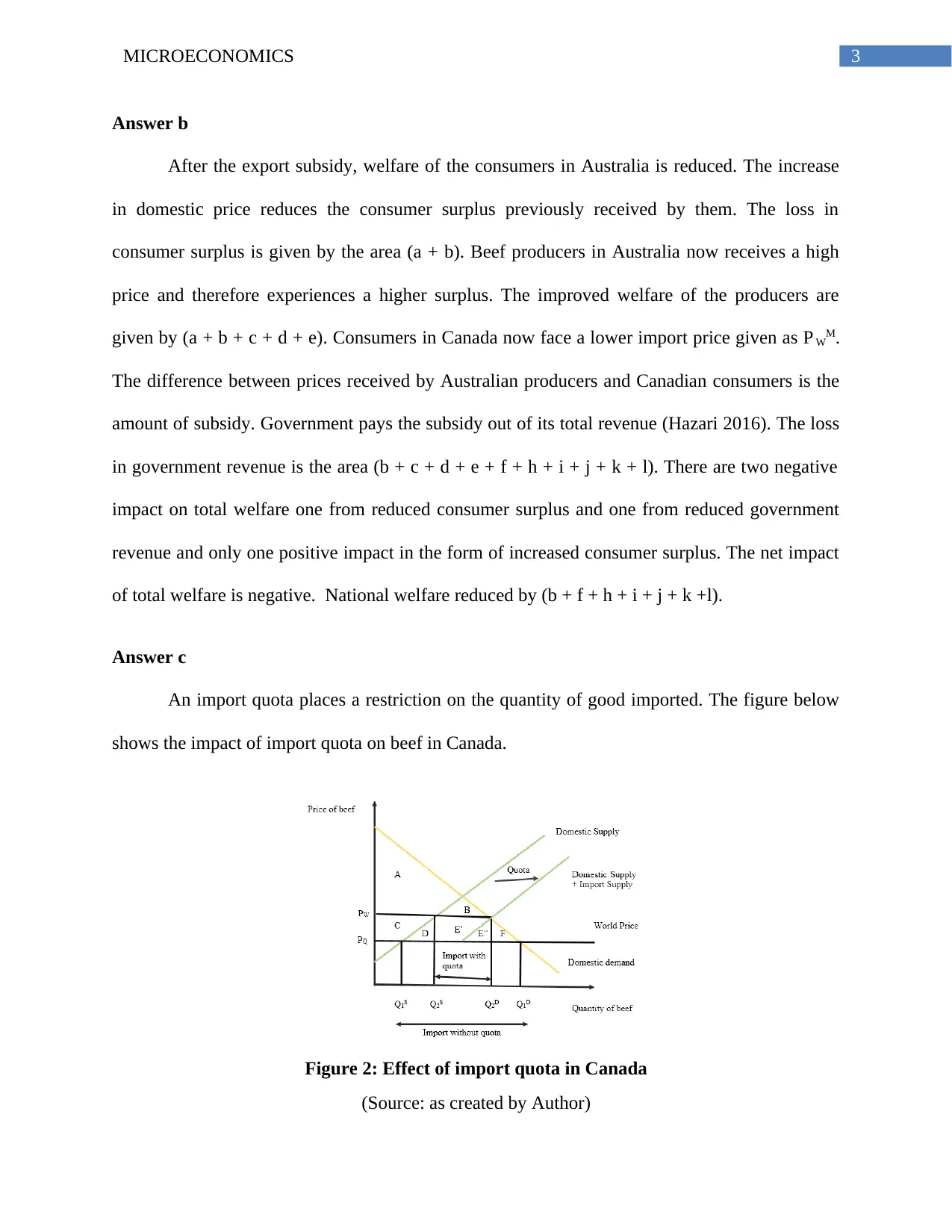
3MICROECONOMICS
Answer b
After the export subsidy, welfare of the consumers in Australia is reduced. The increase
in domestic price reduces the consumer surplus previously received by them. The loss in
consumer surplus is given by the area (a + b). Beef producers in Australia now receives a high
price and therefore experiences a higher surplus. The improved welfare of the producers are
given by (a + b + c + d + e). Consumers in Canada now face a lower import price given as P WM.
The difference between prices received by Australian producers and Canadian consumers is the
amount of subsidy. Government pays the subsidy out of its total revenue (Hazari 2016). The loss
in government revenue is the area (b + c + d + e + f + h + i + j + k + l). There are two negative
impact on total welfare one from reduced consumer surplus and one from reduced government
revenue and only one positive impact in the form of increased consumer surplus. The net impact
of total welfare is negative. National welfare reduced by (b + f + h + i + j + k +l).
Answer c
An import quota places a restriction on the quantity of good imported. The figure below
shows the impact of import quota on beef in Canada.
Figure 2: Effect of import quota in Canada
(Source: as created by Author)
Answer b
After the export subsidy, welfare of the consumers in Australia is reduced. The increase
in domestic price reduces the consumer surplus previously received by them. The loss in
consumer surplus is given by the area (a + b). Beef producers in Australia now receives a high
price and therefore experiences a higher surplus. The improved welfare of the producers are
given by (a + b + c + d + e). Consumers in Canada now face a lower import price given as P WM.
The difference between prices received by Australian producers and Canadian consumers is the
amount of subsidy. Government pays the subsidy out of its total revenue (Hazari 2016). The loss
in government revenue is the area (b + c + d + e + f + h + i + j + k + l). There are two negative
impact on total welfare one from reduced consumer surplus and one from reduced government
revenue and only one positive impact in the form of increased consumer surplus. The net impact
of total welfare is negative. National welfare reduced by (b + f + h + i + j + k +l).
Answer c
An import quota places a restriction on the quantity of good imported. The figure below
shows the impact of import quota on beef in Canada.
Figure 2: Effect of import quota in Canada
(Source: as created by Author)
Paraphrase This Document
Need a fresh take? Get an instant paraphrase of this document with our AI Paraphraser
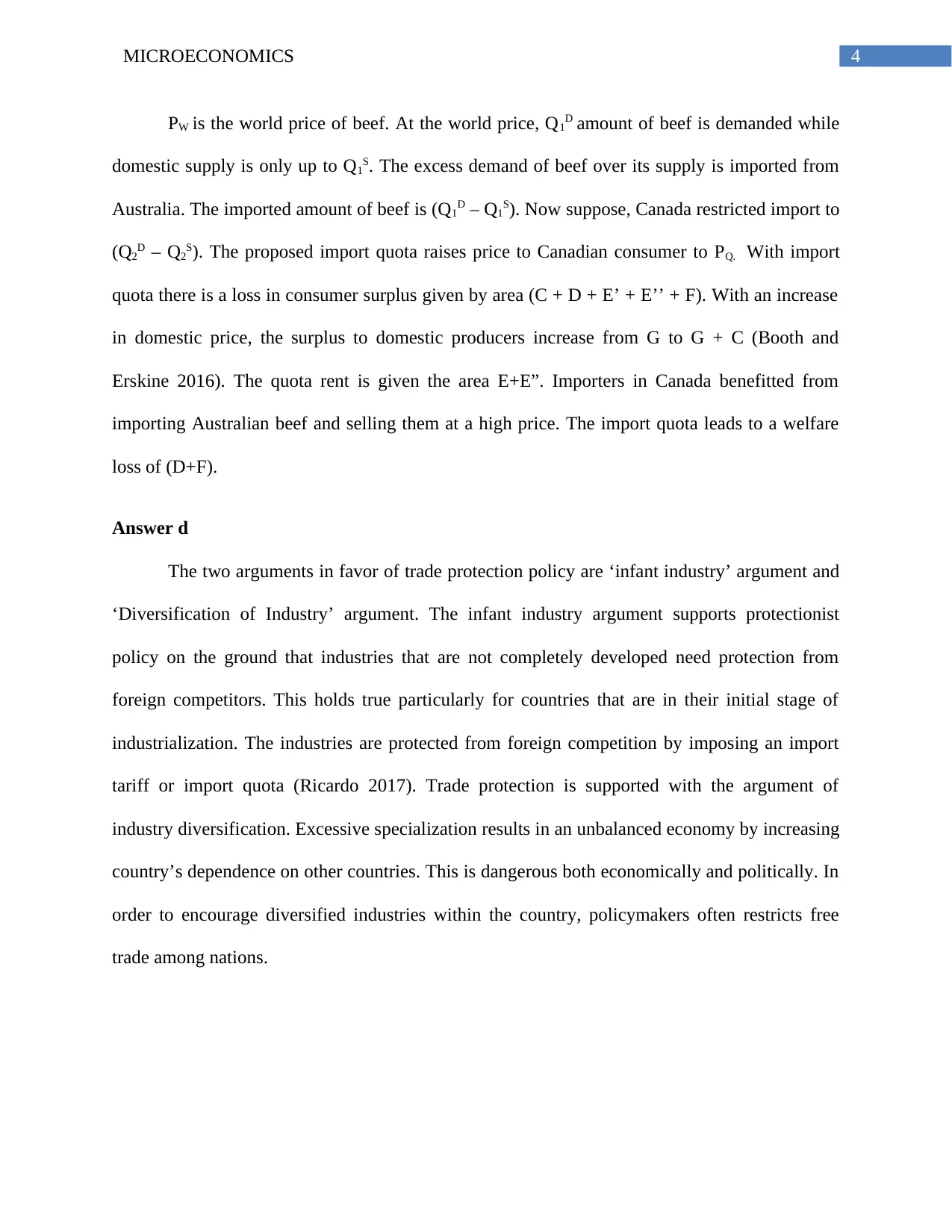
4MICROECONOMICS
PW is the world price of beef. At the world price, Q1D amount of beef is demanded while
domestic supply is only up to Q1S. The excess demand of beef over its supply is imported from
Australia. The imported amount of beef is (Q1D – Q1S). Now suppose, Canada restricted import to
(Q2D – Q2S). The proposed import quota raises price to Canadian consumer to PQ. With import
quota there is a loss in consumer surplus given by area (C + D + E’ + E’’ + F). With an increase
in domestic price, the surplus to domestic producers increase from G to G + C (Booth and
Erskine 2016). The quota rent is given the area E+E”. Importers in Canada benefitted from
importing Australian beef and selling them at a high price. The import quota leads to a welfare
loss of (D+F).
Answer d
The two arguments in favor of trade protection policy are ‘infant industry’ argument and
‘Diversification of Industry’ argument. The infant industry argument supports protectionist
policy on the ground that industries that are not completely developed need protection from
foreign competitors. This holds true particularly for countries that are in their initial stage of
industrialization. The industries are protected from foreign competition by imposing an import
tariff or import quota (Ricardo 2017). Trade protection is supported with the argument of
industry diversification. Excessive specialization results in an unbalanced economy by increasing
country’s dependence on other countries. This is dangerous both economically and politically. In
order to encourage diversified industries within the country, policymakers often restricts free
trade among nations.
PW is the world price of beef. At the world price, Q1D amount of beef is demanded while
domestic supply is only up to Q1S. The excess demand of beef over its supply is imported from
Australia. The imported amount of beef is (Q1D – Q1S). Now suppose, Canada restricted import to
(Q2D – Q2S). The proposed import quota raises price to Canadian consumer to PQ. With import
quota there is a loss in consumer surplus given by area (C + D + E’ + E’’ + F). With an increase
in domestic price, the surplus to domestic producers increase from G to G + C (Booth and
Erskine 2016). The quota rent is given the area E+E”. Importers in Canada benefitted from
importing Australian beef and selling them at a high price. The import quota leads to a welfare
loss of (D+F).
Answer d
The two arguments in favor of trade protection policy are ‘infant industry’ argument and
‘Diversification of Industry’ argument. The infant industry argument supports protectionist
policy on the ground that industries that are not completely developed need protection from
foreign competitors. This holds true particularly for countries that are in their initial stage of
industrialization. The industries are protected from foreign competition by imposing an import
tariff or import quota (Ricardo 2017). Trade protection is supported with the argument of
industry diversification. Excessive specialization results in an unbalanced economy by increasing
country’s dependence on other countries. This is dangerous both economically and politically. In
order to encourage diversified industries within the country, policymakers often restricts free
trade among nations.
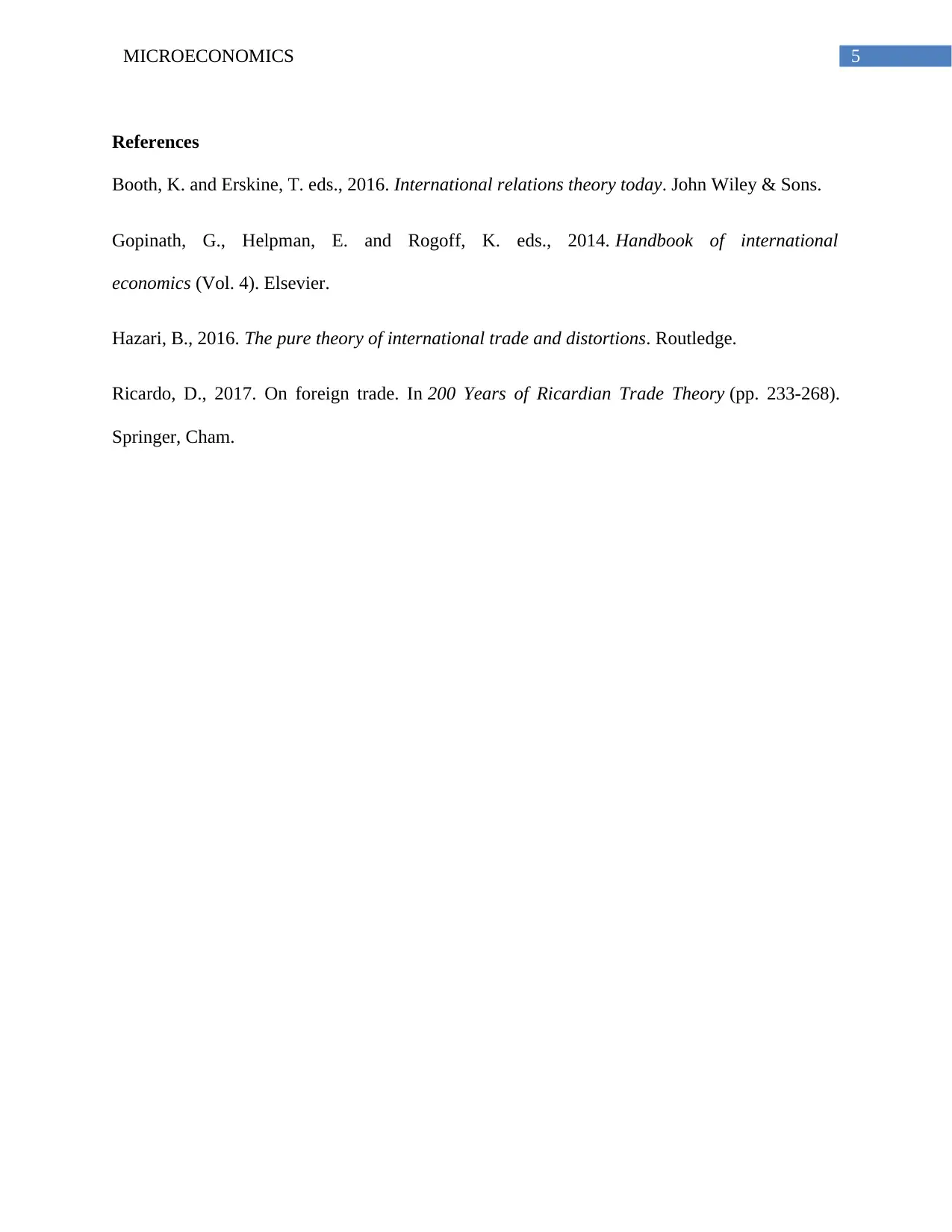
5MICROECONOMICS
References
Booth, K. and Erskine, T. eds., 2016. International relations theory today. John Wiley & Sons.
Gopinath, G., Helpman, E. and Rogoff, K. eds., 2014. Handbook of international
economics (Vol. 4). Elsevier.
Hazari, B., 2016. The pure theory of international trade and distortions. Routledge.
Ricardo, D., 2017. On foreign trade. In 200 Years of Ricardian Trade Theory (pp. 233-268).
Springer, Cham.
References
Booth, K. and Erskine, T. eds., 2016. International relations theory today. John Wiley & Sons.
Gopinath, G., Helpman, E. and Rogoff, K. eds., 2014. Handbook of international
economics (Vol. 4). Elsevier.
Hazari, B., 2016. The pure theory of international trade and distortions. Routledge.
Ricardo, D., 2017. On foreign trade. In 200 Years of Ricardian Trade Theory (pp. 233-268).
Springer, Cham.
⊘ This is a preview!⊘
Do you want full access?
Subscribe today to unlock all pages.

Trusted by 1+ million students worldwide
1 out of 6
Related Documents
Your All-in-One AI-Powered Toolkit for Academic Success.
+13062052269
info@desklib.com
Available 24*7 on WhatsApp / Email
![[object Object]](/_next/static/media/star-bottom.7253800d.svg)
Unlock your academic potential
Copyright © 2020–2025 A2Z Services. All Rights Reserved. Developed and managed by ZUCOL.





